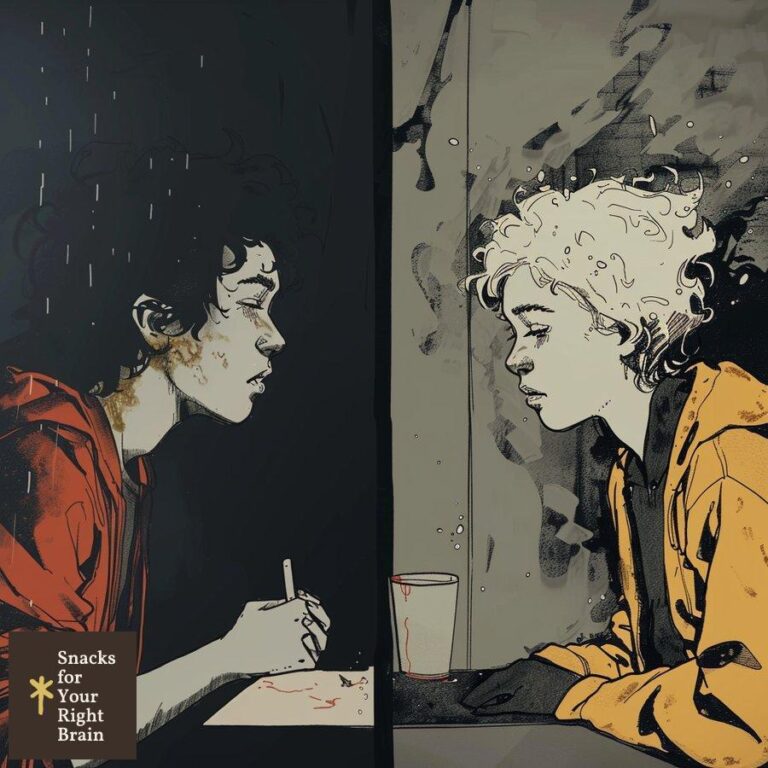What Is a Foil Character in a Short Story
What is a foil character in literature?
A foil character is a literary device used to contrast and highlight the traits, behaviors, and motivations of another character, typically the protagonist, in a story. By juxtaposing two characters with opposing qualities, the author can make the protagonist’s personality more vivid, complex, and compelling to the reader.
The term “foil” originates from the practice of placing a thin layer of foil behind a gemstone to make it appear brighter and more reflective. Similarly, a foil character serves as a backdrop that makes the protagonist’s unique qualities stand out more clearly.
Foil characters can take on various roles in a story, such as:
- Antagonist: A character who directly opposes the protagonist’s goals and values
- Sidekick: A character who accompanies and supports the protagonist
- Love interest: A character who has a romantic relationship with the protagonist
- Mentor: A character who guides and teaches the protagonist
Regardless of their specific role, foil characters are essential tools for authors to develop their protagonists and convey deeper themes and messages through the contrast between the two characters.
How do foil characters enhance short stories?
Foil characters play a crucial role in enhancing short stories by:
-
Revealing the protagonist’s personality: By highlighting the protagonist’s unique traits and behaviors through contrast, foil characters help readers understand the protagonist more deeply and empathize with them.
-
Driving the plot forward: The conflict and tension created by the differences between the protagonist and foil character can propel the story’s events and create engaging complications for the protagonist to overcome.
-
Conveying themes: The contrast between the protagonist and foil character can symbolize larger themes and ideas that the author wants to explore, such as good vs. evil, tradition vs. progress, or idealism vs. pragmatism.
-
Creating memorable moments: The interactions and confrontations between the protagonist and foil character can lead to some of the most memorable and impactful scenes in a short story, as the characters’ differences come to a head.
-
Providing balance: Foil characters can serve as a counterpoint to the protagonist, offering a different perspective or approach that adds depth and nuance to the story’s overall narrative.
By leveraging these benefits, authors can use foil characters to elevate their short stories and create a more engaging, thought-provoking reading experience for their audience.
What are the key characteristics of effective foil characters?
Effective foil characters share several key characteristics that make them compelling and impactful within a short story:
-
Clear contrast with the protagonist: The foil character should have traits, behaviors, and motivations that are distinctly different from those of the protagonist, creating a strong sense of opposition and tension between the two characters.
-
Depth and complexity: While serving as a contrast to the protagonist, the foil character should also have their own unique personality, backstory, and character arc. A one-dimensional foil character can feel flat and unengaging.
-
Relevance to the story’s themes: The foil character’s role and function should be closely tied to the central themes and ideas that the author wants to explore in the short story. Their contrast with the protagonist should illuminate these themes in meaningful ways.
-
Memorable and distinctive: A good foil character should leave a lasting impression on the reader, with a unique voice, mannerisms, and personality that set them apart from other supporting characters in the story.
-
Believable and realistic: Despite their role as a contrast to the protagonist, foil characters should still feel like authentic, three-dimensional individuals within the story’s world, with their own motivations and decision-making processes.
By embodying these characteristics, foil characters can elevate a short story and make it a more engaging, thought-provoking, and memorable reading experience for the audience.
How do different types of foil characters function in short stories?
Foil characters can take on various forms and serve different functions within a short story, depending on their specific role and relationship to the protagonist:
Antagonist foils
Antagonist foils are characters who directly oppose the protagonist’s goals and values, creating a central conflict that drives the story’s events. They often have a strong personal connection to the protagonist, such as a rival, nemesis, or even a family member. By embodying the protagonist’s antithesis, antagonist foils can push the protagonist to grow, change, and overcome obstacles.
Sidekick foils
Sidekick foils are characters who accompany and support the protagonist throughout the story, often providing a contrast to the protagonist’s personality and approach. They can serve as a sounding board, confidant, or voice of reason, offering a different perspective that challenges the protagonist’s assumptions and decisions. Sidekick foils can also provide comic relief or emotional support, adding depth and nuance to the protagonist’s journey.
Love interest foils
Love interest foils are characters who have a romantic relationship with the protagonist, creating a unique dynamic that highlights the protagonist’s personality and values. They can either share common ground with the protagonist, creating a sense of connection and understanding, or have opposing traits and beliefs, leading to conflict and tension. Love interest foils can also serve as a catalyst for the protagonist’s personal growth and self-discovery.
Mentor foils
Mentor foils are characters who guide and teach the protagonist, offering wisdom, knowledge, and experience that the protagonist lacks. They can serve as a moral compass, challenging the protagonist’s assumptions and pushing them to grow beyond their limitations. Mentor foils can also represent the protagonist’s ideal self or a path not taken, creating a complex and nuanced relationship between the two characters.
By understanding the different types of foil characters and their functions, authors can create more engaging and impactful short stories that resonate with readers on a deeper level.
What are some notable examples of foil characters in famous short stories?
Some notable examples of foil characters in famous short stories include:
-
Sherlock Holmes and Dr. Watson in Arthur Conan Doyle’s Sherlock Holmes stories: Holmes, the brilliant but eccentric detective, is contrasted with the more grounded and logical Watson, who serves as both a sidekick and a foil to Holmes’ unconventional methods and personality.
-
The Misfit and the grandmother in Flannery O’Connor’s “A Good Man Is Hard to Find”: The Misfit, a dangerous criminal, serves as a foil to the grandmother, a seemingly pious and proper woman, highlighting the complexities of morality and human nature.
-
Montresor and Fortunato in Edgar Allan Poe’s “The Cask of Amontillado”: Montresor, the narrator and protagonist, is contrasted with Fortunato, his unsuspecting victim, creating a chilling tale of revenge and the consequences of hubris.
-
Rainsford and Zaroff in Richard Connell’s “The Most Dangerous Game”: Rainsford, a big-game hunter, is pitted against Zaroff, a fellow hunter who has taken his sport to a horrifying extreme, creating a tense and thrilling story about the nature of humanity.
-
Sammy and Stokesie in John Updike’s “A&P”: Sammy, the protagonist, is contrasted with his co-worker Stokesie, who represents the conformity and complacency that Sammy rebels against, setting the stage for Sammy’s coming-of-age and decision to quit his job.
These examples demonstrate how foil characters can take on various forms and serve different functions within a short story, from highlighting the protagonist’s unique qualities to driving the plot forward and conveying deeper themes and ideas.
How can writers create compelling foil characters within the constraints of short fiction?

Creating compelling foil characters within the constraints of short fiction can be challenging, but there are several strategies writers can employ to make the most of this literary device:
-
Establish the contrast quickly: In a short story, there is limited space to develop characters and their relationships. Writers should aim to establish the key differences between the protagonist and foil character as soon as possible, using dialogue, actions, and descriptions to create a clear sense of opposition.
-
Focus on a few defining traits: With limited space, writers should choose a few defining traits or qualities that will serve as the basis for the contrast between the protagonist and foil character. These traits should be relevant to the story’s themes and the protagonist’s character arc.
-
Use backstory and context sparingly: While backstory and context can help flesh out foil characters, writers should use these elements judiciously in a short story. Focus on the most relevant and impactful details that will enhance the contrast and drive the plot forward.
-
Create memorable moments of interaction: The interactions and confrontations between the protagonist and foil character are where the contrast comes alive. Writers should aim to create a few memorable, impactful scenes that showcase the characters’ differences and the consequences of those differences.
-
Tie the foil character to the story’s themes: Ensure that the foil character’s role and function are closely tied to the central themes and ideas that the writer wants to explore in the short story. The contrast between the protagonist and foil character should illuminate these themes in meaningful ways.
-
Leave room for ambiguity and interpretation: While establishing a clear contrast is important, writers should also leave room for ambiguity and interpretation. By avoiding simplistic or one-dimensional portrayals of the protagonist and foil character, writers can create more complex and thought-provoking stories that engage readers on a deeper level.
By employing these strategies, writers can create compelling foil characters that enhance their short stories and leave a lasting impression on their readers.
What role do foil characters play in developing theme and symbolism?
Foil characters play a crucial role in developing theme and symbolism within a short story by:

-
Embodying opposing ideas and values: The contrast between the protagonist and foil character can represent larger themes and ideas, such as good vs. evil, tradition vs. progress, or idealism vs. pragmatism. By embodying these opposing values, foil characters help to crystallize the story’s central themes.
-
Serving as symbolic representations: Foil characters can serve as symbolic representations of larger concepts or forces at work in the story’s world. For example, a foil character who represents the corrupting influence of power can symbolize the dangers of unchecked ambition.
-
Highlighting the protagonist’s internal conflict: The contrast between the protagonist and foil character can highlight the protagonist’s own internal struggles and conflicts. As the protagonist grapples with the foil character’s opposing views and actions, they may be forced to confront their own assumptions and beliefs.
-
Providing a lens for exploring moral and ethical questions: Foil characters can help writers explore complex moral and ethical questions by presenting alternative perspectives and approaches. By juxtaposing the protagonist’s actions and beliefs with those of the foil character, writers can create thought-provoking scenarios that challenge readers to consider different sides of an issue.
-
Serving as a catalyst for character growth: The protagonist’s interactions with the foil character can serve as a catalyst for personal growth and self-discovery. As the protagonist confronts the foil character’s opposition, they may be forced to re-evaluate their own beliefs and behaviors, leading to a deeper understanding of themselves and the world around them.
By leveraging these functions, writers can use foil characters to develop rich, multi-layered themes and symbolism within their short stories, creating a more engaging and thought-provoking reading experience for their audience.
How do foil characters differ from other supporting characters in short stories?
While all supporting characters in a short story play a role in shaping the protagonist’s journey and the overall narrative, foil characters differ from other supporting characters in several key ways:
-
Degree of contrast with the protagonist: Foil characters are specifically chosen to contrast with the protagonist in clear and significant ways, while other supporting characters may have more subtle differences or similarities.
-
Relevance to the story’s themes: Foil characters are closely tied to the central themes and ideas that the writer wants to explore, while other supporting characters may serve more peripheral functions.
-
Impact on the protagonist’s character arc: Foil characters have a direct and significant impact on the protagonist’s personal growth and decision-making, while other supporting characters may have a more indirect influence.
-
Memorable and distinctive qualities: Foil characters tend to be more memorable and distinctive than other supporting characters, with a clear personality and role within the story.
-
Potential for character development: While other supporting characters may have their own arcs and growth, foil characters often undergo significant development as they confront the protagonist and their own beliefs.
It’s important to note that the line between foil characters and other supporting characters can sometimes be blurred, as writers may use a combination of contrast and similarity to create complex and nuanced relationships between characters. However, by understanding the unique functions and characteristics of foil characters, writers can create more effective and impactful short stories that resonate with readers on a deeper level.
What techniques can readers use to identify and analyze foil characters?
Readers can use several techniques to identify and analyze foil characters in short stories:

-
Look for clear contrasts: Identify the key differences between the protagonist and other characters, such as personality traits, values, goals, and behaviors. These contrasts are often the most obvious indicators of a foil character.
-
Consider the characters’ interactions: Pay attention to how the protagonist and foil character interact with each other, especially in moments of conflict or tension. These interactions can reveal the underlying differences between the characters and the significance of their relationship.
-
Analyze the characters’ actions and decisions: Look for instances where the protagonist and foil character make different choices or take different actions in response to the same situation. These differences can highlight the characters’ opposing values and beliefs.
-
Examine the characters’ backstories and contexts: Consider how the protagonist and foil character’s backgrounds, experiences, and social contexts may have shaped their personalities and worldviews. These factors can contribute to the contrast between the characters.
-
Connect the foil character to the story’s themes: Identify the central themes and ideas that the writer is exploring and consider how the foil character’s role and function relate to these themes. The contrast between the protagonist and foil character can often illuminate the story’s themes in meaningful ways.
-
Look for symbolic representations: Consider whether the foil character may be serving as a symbolic representation of larger concepts or forces at work in the story’s world. The contrast between the protagonist and foil character can sometimes represent broader societal or philosophical issues.
By employing these techniques, readers can develop a deeper understanding of foil characters and their significance within the context of a short story. This analysis can lead to a richer and more nuanced appreciation of the writer’s craft and the story’s overall themes and messages.
How can writers avoid common pitfalls when crafting foil characters?
While foil characters can be a powerful tool for enhancing short stories, there are several common pitfalls that writers should be aware of and avoid:
-
Oversimplifying the contrast: Writers should be careful not to create a one-dimensional contrast between the protagonist and foil character. Both characters should have depth, complexity, and nuance, with their own motivations, backstories, and character arcs.

-
Neglecting the foil character’s development: Foil characters should not be mere plot devices or caricatures. Writers should invest time in developing the foil character’s personality, relationships, and growth, ensuring that they feel like a fully realized individual within the story’s world.
-
Relying too heavily on stereotypes: While foil characters often represent opposing ideas or values, writers should avoid falling back on stereotypes or clichés when crafting these characters. Foil characters should feel authentic and grounded in the story’s context.
-
Failing to integrate the foil character into the plot: Foil characters should not feel like an afterthought or a separate storyline within the short story. Writers should ensure that the foil character’s role and function are seamlessly integrated into the overall narrative and contribute to the story’s progression and resolution.
-
Neglecting the protagonist’s growth: While foil characters can highlight the protagonist’s unique qualities, writers should ensure that the protagonist undergoes meaningful growth and change as a result of their interactions with the foil character. The contrast between the characters should lead to a deeper understanding or transformation for the protagonist.
-
Overusing foil characters: While foil characters can be a powerful tool, writers should be careful not to overuse them within a short story. Too many contrasting characters can lead to confusion, dilute the impact of the contrast, and make the story feel overly schematic or didactic.
By being aware of these pitfalls and taking steps to avoid them, writers can craft foil characters that enhance their short stories and create a more engaging and thought-provoking reading experience for their audience.






